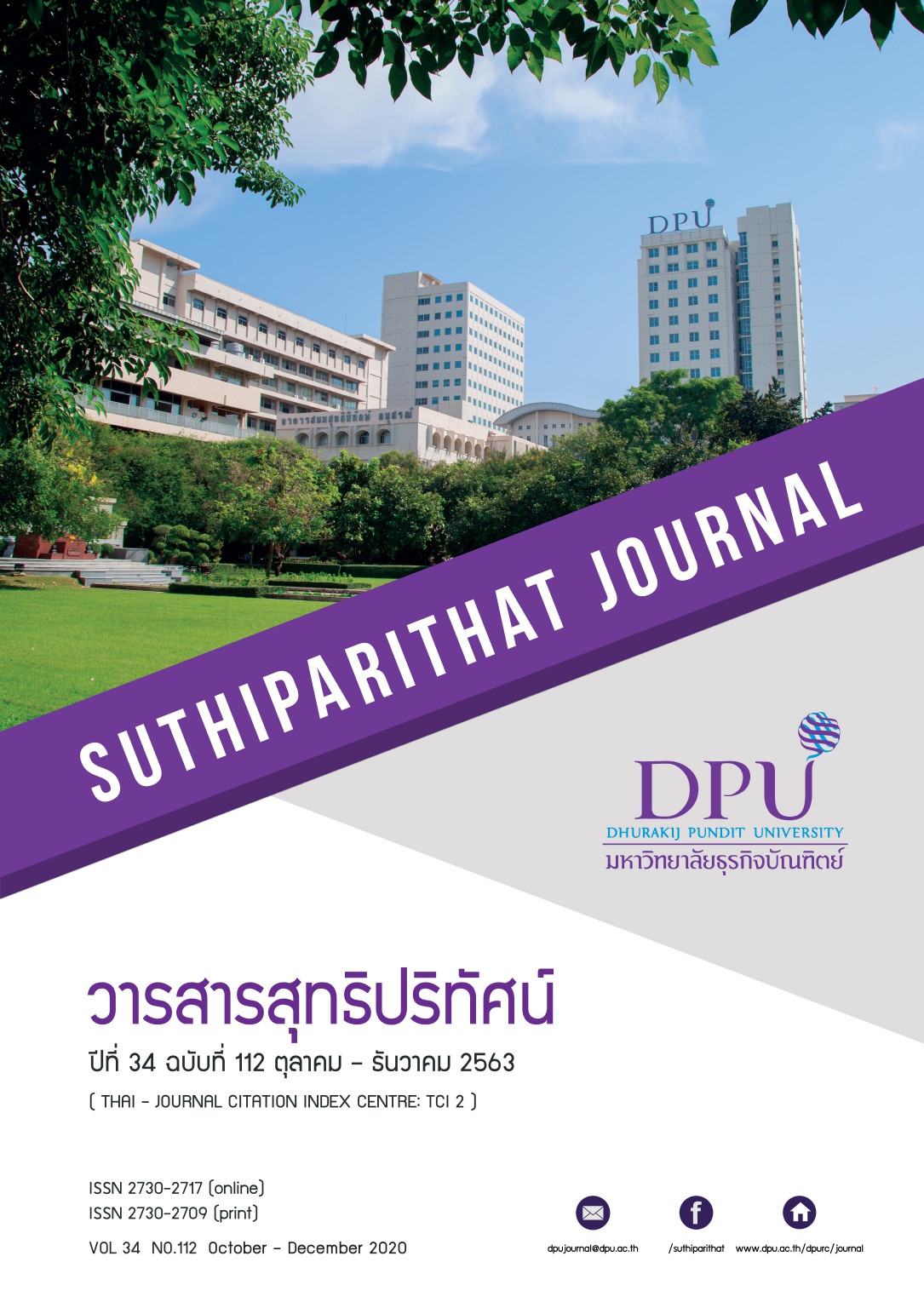การเติบโตทางเศรษฐกิจรายสาขาสามารถลดปัญหาความยากจนได้หรือไม่ กรณีศึกษา ประเทศไทย
คำสำคัญ:
การเติบโตทางเศรษฐกิจ, การเติบโตทางเศรษฐกิจรายสาขา, ปัญหาความยากจนบทคัดย่อ
ประเทศไทยมีพัฒนาการด้านการลดปัญหาความยากจนได้อย่างน่าประทับใจในระยะสิบปีที่ผ่านมา ถึงอย่างไรก็ตาม ในปี 2560 ยังคงมีคนไทยมากถึง 5.33 ล้านคนที่ยังประสบกับความยากจน และมีคนไทยจำนวนมากถึง 620,540 คน ประสบปัญหาความยากจนขั้นรุงแรง องค์กรระหว่างประเทศได้นำเสนอแนวทางการลดปัญหาความยากจนอย่างหลากหลาย รวมถึงข้อวิธีการทางทฤษฎี งานวิจัยชิ้นนี้มีวัตถุประสงค์เพื่อวิเคราะห์บทบาทของการเติบโตทางเศรษฐกิจและการลดความยากจนจากมุมมองทางเศรษฐกิจมหาภาค ตลอดจนพิสูจว่าการเติบโตทางเศรษฐกิจรายสาขาได้แก่ การเติบโตภาคเกษตร ภาคอุตสาหกรรม และภาคบริการ สามารถลดความยากจนได้จริงหรือไม่ ผลการศึกษาเชิงประจักษ์จากการประมาณค่าสมการเชิงเส้นตรงชี้ให้เห็นว่าการเติบโตทางเศรษฐกิจโดยรวมและรายสาขาสามารถลดความยากจนได้อย่างมีนัยสำคัญ ซึ่งสอดคล้องกับทฤษฎีการเติบโตทางเศรษฐกิจ (Economic Growth Theory) ขณะเดียวกันราคาสินค้ากลุ่มอาหารที่เพิ่มสูงขึ้นทำให้ปัญหาความยากจนรุนแรงขึ้น ในกรณีศึกษาประเทศไทย พบว่าการเติบโตทางเศรษฐกิจรายสาขาทำให้ความยากจนลดลง แต่เฉพาะการเติบโตภาคบริการเท่านั้น
เอกสารอ้างอิง
Abhijit V. Banerjee, & Esther Duflo. (2007). The economic lives of the poor. Journal of Economic Perspectives, 21(1), 141–167.
Astia Dendi et.al. (2004). Alleviating poverty through local economic development lessons from Nusa Tenggara. Tenggara Provinces: PROMIS-NT.
Bassford, T. (2010). Breaking the cycle of poverty through holistic sustainable community development. Significant Matters, Inc.
Booth, A. (2019). What have we learned? In living standards in Southeast Asia: Changes over the long Twentieth Century, 1900-2015 (pp. 263-284). Amsterdam: Amsterdam University Press. doi:10.2307/j.ctvsr51jr.13
Casse, T., & Jensen, S. (2009). Do we understand the linkages between economic growth, poverty targets and poverty reduction?. Review of African Political Economy, 36(122), 539-553. Retrieved November 6, 2020, from http://www.jstor.org/stable/27756310
CSF. (2016). Time for a holistic approach to rural poverty. Retrieved from http://www.fao.org/cfs/home/blog/blog-articles/article/en/c/447515/
CVBN. (2012). A holistic approach to poverty reduction: livelihood improvement group mechanism. Retrieved from http://vcbnetwork.org/library/a-holistic-approach-to-poverty-reduction-livelihood-improvement-group-mechanism
Deaton, A. (2008). Income, health, and well-being around the world: Evidence from the gallup world poll. Journal of Economic Perspectives, 22(2), 53–72.
De Janvry, A., & Sadoulet, E. (2010). Agricultural growth and poverty reduction: Additional evidence. The World Bank Research Observer, 25(1), 1-20. Retrieved November 6, 2020, from http://www.jstor.org/stable/40649308
Eegunlusi, T. R. (2016). Africa, poverty and forces of change: A holistic approach to perceiving and addressing poverty in Africa. Scientific Research Publishing, Open Journal of Philosophy, 6(4), 368-391.
ESI. (2011). Local economic development tools, An introduction for municipalitiesand local economic service providers in Bosnia and Herzegovina. European Stability Initiative-ESI.
Feder, G., Gilligan, D., Jacoby, H., Bresciani, F., Onchan, T., & Quizon, J. (2002). Weathering the storm: The impact of the East Asian crisis on farm households in Indonesia and Thailand. World Bank Research Observer, 17, 1–20. https://doi.org/10.1093/wbro/17.1.1
Hayes, J. (2005). prosperitynow. Retrieved from https://www.prosperitynow.org/blog/how-use-behavioral-science-help-end-poverty
Hainsworth, G. (1979). Economic growth and poverty in Southeast Asia: Malaysia, Indonesia and the Philippines. Pacific Affairs, 52(1), 5-41. doi:10.2307/2757764
Kakwani, N., & Medhi Krongkaew. (1998). Poverty in Thailand: Defining, measuring and analyzing. Working Paper No.4, Asian Development Bank and Development Evaluation Division, NESDB.
Laosutsan, P., Shivakoti, G., & Soni, P. (2019). Factors influencing the adoption of good agricultural practices and export decision of Thailand’s vegetable farmers. International Journal of the Commons, 13(2), 867-880. doi:10.2307/26819574
Mahlalela, S. (2014). Investigating the role of LED as a tool for poverty alleviation in Mbombela Municipality. Johannesburg: Faculty of Engineering and Built Environment, University of Witwatersrand.
Mandela, N. (2011). Nelson Mandela by himself: The authorised book of quotations.
Mizuno, A. (2020). Labour migration and relocation of apparel production between Thailand and Myanmar. Journal of Southeast Asian Economies, 37(2), 181-198. doi:10.2307/26938872
NESDB. (2019). Socio-economic survey of households. Bangkok: National Statistical Office.
Northrop, E. (1988). Economic growth and poverty reductions: Important mitigating factors. Eastern Economic Journal, 14(4), 349-356. Retrieved November 6, 2020, from http://www.jstor.org/stable/40325235
P. Athukorala, & K. Sen. (2015). Industrialisation, employment and poverty. Forthcoming. In Michael Tribe & John Weiss (Eds.), Routledge handbook of industrial (pp. 84- 95).
Ravallion, M. (2009). A comparative perspective in Brazil, China and India. Policy Research Working Paper 5080.
Somporn Isvilanonda, Ahmad, A., & Hossain, M. (2000). Recent changes in Thailand's rural economy: Evidence from six villages. Economic and Political Weekly, 35(52/53), 4644-4649.
Soontaranurak, K., & Dawson, P. (2015). Rubber acreage supply response In Thailand: A cointegration approach. The Journal of Developing Areas, 49(2), 23-38.
Sukanlaya Choenkwan, Arunee Promkhambut, Fukui Hayao, & A. Terry Rambo. (2016). Does agrotourism benefit mountain farmers? A case study in Phu Ruea District, Northeast Thailand. Mountain Research and Development, 36(2), 162-172.
Sukanlaya Choenkwan, Jefferson Metz Fox, & A. Terry Rambo. (2014). Agriculture in the mountains of Northeastern Thailand: Current situation and prospects for development. Mountain Research and Development, 34(2), 95-106.
United Nation. (2017). Urging holistic approach to end poverty, non-governmental groups press social development commission to address broad concerns of most vulnerable. Author.
Warr, P. (2009). Poverty reduction through long-term growth: The Thai experience. Asian Economic Papers, 51-76.
Warr, P. (2018). Poverty reduction and economic growth In Southeast Asia. Thammasat Economic Journal, 1-31.
Winters et al. (2004, March). Trade liberalization and poverty: The evidence so far. Journal of Economic Literature, XLII, 72–115.
World Bank. (2003). The poverty reduction strategy initiative. Washington, D.C.: World Bank.
World Bank. (2005). Poverty manual, All, JH Revision. World Bank group.
World Bank. (2015). Household survey data. World Bank, Development Research Group.
World Bank. (2017). It’s time for Thailand to get back on track. World Bank Group.
ดาวน์โหลด
เผยแพร่แล้ว
รูปแบบการอ้างอิง
ฉบับ
ประเภทบทความ
สัญญาอนุญาต
เนื้อหาและข้อมูลในบทความที่ลงตีพิมพ์ในวารสารสุทธิปริทัศน์ ถือเป็นข้อคิดเห็นและความรับผิดชอบของผู้เขียนบทความโดยตรงซึ่งกองบรรณาธิการวารสาร ไม่จำเป็นต้องเห็นด้วย หรือร่วมรับผิดชอบใด ๆ
บทความ ข้อมูล เนื้อหา รูปภาพ ฯลฯ ที่ได้รับการตีพิมพ์ในวารสารสุทธิปริทัศน์ ถือเป็นลิขสิทธิ์ของวารสารสุทธิปริทัศน์หากบุคคลหรือหน่วยงานใดต้องการนำทั้งหมดหรือส่วนหนึ่งส่วนใดไปเผยแพร่ต่อหรือเพื่อกระทำการใด ๆ จะต้องได้รับอนุญาตเป็นลายลักษณ์อักษรจากวารสารสุทธิปริทัศน์ก่อนเท่านั้น







